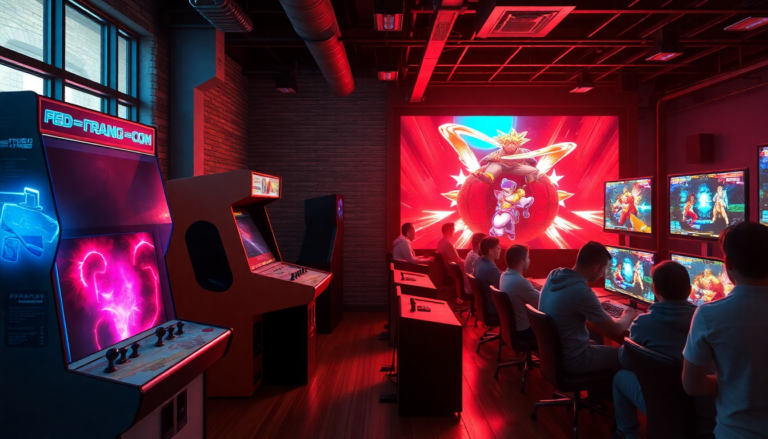Argomenti trattati
Fighting games have long captivated players with their blend of hand-to-hand combat and strategic gameplay. Who can forget the thrill of pulling off that perfect combo or the adrenaline rush of a sudden death match? As a genre, fighting games have morphed dramatically from their humble beginnings in the arcades to the expansive 3D arenas we see today. The journey is not just about technological advancements; it’s also about cultural shifts, player communities, and the sheer joy of competition.
The beginnings of fighting games
It all started in 1976 with Heavyweight Champ, the first game to feature fist fighting. But it wasn’t until 1984, with Karate Champ, that we saw the birth of the one-on-one fighting game genre. I remember when I first encountered it in my local arcade—the excitement was palpable. Players used dual joysticks to perform a variety of moves, setting a precedent for future titles. Fast forward to 1991, and Street Fighter II arrived on the scene, revolutionizing the genre with its special moves and combo mechanics. This game didn’t just hit the arcade; it exploded into the cultural consciousness, solidifying fighting games as a staple of gaming culture.
Key mechanics and gameplay
At the heart of fighting games lies a rich tapestry of mechanics. Players engage in combat using a mix of blocking, grappling, and chaining attacks into combos. I remember the first time I successfully executed a combo in Street Fighter II; it felt like magic. Each character brings unique fighting styles and special moves, often inspired by martial arts or fantastical elements. From the classic Hadouken to the intricate combos in Tekken, the variety keeps players engaged and returning for more.
The gameplay typically unfolds on a 2D plane, even in 3D titles, where players can move left and right, jump, and execute their moves. This confinement of movement creates a dynamic environment where strategy is crucial. Advanced techniques like parrying or countering can turn the tide of battle, transforming what seems like an inevitable defeat into a glorious comeback—just like I experienced during my first tournament, where every decision felt like it could lead to victory or disaster.
The rise of 3D fighting games
As technology advanced, so did the genre. The introduction of 3D graphics in games like Virtua Fighter in 1993 changed the landscape entirely. While still rooted in the classic fighting mechanics, these games allowed players to explore a more dynamic space, adding depth to the combat system. I fondly recall playing Dead or Alive and being mesmerized by the graphics and the fluidity of the character movements. This shift not only provided a visual feast but also opened new avenues for gameplay, with sidestepping and complex maneuvers becoming integral to player strategy.
The impact of cultural phenomena
Fighting games have always drawn inspiration from popular culture, especially martial arts films. Titles like Mortal Kombat took this a step further, introducing brutal finishing moves called Fatalities, which sparked discussions about violence in gaming. I vividly remember the uproar surrounding Mortal Kombat’s release—it felt like a cultural event. The game became a lightning rod for debates on violence in video games, yet it also captured the imagination of players, paving the way for sequels and a franchise that still thrives today.
The rivalry between franchises like Street Fighter and Mortal Kombat fueled innovation and competition within the genre, leading to memorable crossovers and collaborations such as Marvel vs. Capcom. These games not only brought together beloved characters but also showcased the potential for storytelling within fighting games. They transformed mere brawls into epic battles filled with lore and character development, making every match a narrative experience.
The esports phenomenon
In recent years, the rise of esports has breathed new life into fighting games. Tournaments like EVO have become monumental events, drawing players from around the world—each with dreams of glory and the thrill of competition. I often find myself glued to my screen during these tournaments, cheering for my favorite players as they pull off jaw-dropping maneuvers. The community around fighting games is passionate and vibrant, fostering friendships and rivalries that extend beyond the game itself.
The future of fighting games
As we move forward into the 2020s, the fighting game genre continues to evolve. Recent titles like Street Fighter 6 and Mortal Kombat 1 have set the stage for a new generation of gamers, combining nostalgia with innovative gameplay mechanics. With advancements in technology and the growing popularity of online gaming, the future looks bright for fighting games. I can’t help but feel excited about what’s next—new characters, fresh mechanics, and perhaps even more crossovers that push the boundaries of the genre.
Ultimately, fighting games are more than just a means of competition; they are a cultural phenomenon that has brought people together. Whether you’re a seasoned veteran or a newcomer, the thrill of the fight is universal. And who knows? Maybe you’ll find yourself in the next epic showdown, where every punch, kick, and combo matters.

